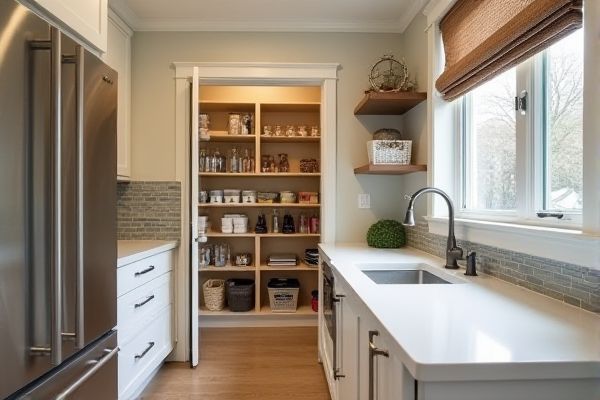
A pull-out pantry offers space-saving convenience with sliding shelves that maximize storage in narrow kitchens, while a walk-in pantry provides expansive room for bulk items and easy organization in a dedicated closet or small room. Discover which pantry style suits Your kitchen layout and lifestyle needs by reading the rest of the article.
Table of Comparison
| Feature | Pull-out Pantry | Walk-in Pantry |
|---|---|---|
| Space Requirement | Compact footprint, fits into narrow spaces or cabinets | Requires a dedicated room or large closet |
| Storage Capacity | Limited to shelf height and width, suitable for smaller kitchens | High capacity, accommodates bulk storage and large items |
| Accessibility | Easy access with sliding shelves, but limited visibility | Full visibility and easy access to all items |
| Installation | Relatively simple, integrates with existing cabinetry | May require construction and dedicated ventilation |
| Customization | Limited to adjustable shelves and pulls | Highly customizable with shelving, lighting, climate control |
| Cost | More affordable, cost-effective for small spaces | Higher cost due to size and construction needs |
| Best For | Small to medium kitchens needing efficient storage | Large kitchens and homes requiring extensive pantry space |
Overview of Pull-Out and Walk-In Pantries
Pull-out pantries maximize narrow kitchen spaces with sliding shelves that allow easy access to items, making organization and visibility efficient. Walk-in pantries provide ample storage with dedicated room for bulk goods, appliances, and multiple shelves, ideal for larger kitchens or households requiring extensive food storage. Your choice depends on kitchen size and storage needs, balancing space utilization with accessibility.
Space Efficiency: Pull-Out vs Walk-In Pantry
Pull-out pantries maximize space efficiency by utilizing narrow, vertical storage areas that make it easier to access items without taking up much floor space. Walk-in pantries offer expansive storage with customizable shelving but require a larger footprint, making them ideal for homes with ample kitchen space. Your choice depends on the available kitchen layout and the balance you want between accessibility and storage capacity.
Storage Capacity Comparison
Pull-out pantries offer limited storage capacity due to their narrow, sliding shelves designed for smaller kitchens or tight spaces. Walk-in pantries provide significantly greater storage capacity, accommodating bulk items, large containers, and multiple shelves for organized, extensive food and supply storage. Optimizing kitchen layout depends on available space and the volume of items to be stored.
Accessibility and Organization
Pull-out pantries offer easy access to stored items by utilizing sliding shelves that bring contents into view, maximizing narrow spaces and enhancing organization through compartmentalized trays. Walk-in pantries provide expansive storage with customizable shelving, allowing for clear categorization of goods and effortless reach across larger areas. Both options improve kitchen efficiency, but pull-out pantries excel in accessibility within compact layouts, while walk-in pantries shine in organization and storage capacity.
Design and Aesthetic Considerations
Pull-out pantries maximize narrow spaces with sleek, vertical storage that maintains a clean kitchen aesthetic, offering easy access to items while minimizing visual clutter. Walk-in pantries provide extensive storage with customizable shelving and open layouts, contributing to a more spacious and luxurious kitchen design. Both designs can be tailored with materials, finishes, and lighting to complement modern or traditional kitchen styles, balancing function with visual appeal.
Installation and Renovation Costs
Pull-out pantries generally have lower installation and renovation costs due to their compact size and simpler mounting requirements, making them ideal for small kitchens or existing cabinetry upgrades. Walk-in pantries involve higher expenses, as they require dedicated space, structural modifications, and customized shelving or storage systems, increasing labor and material costs significantly. Homeowners should consider budget constraints and available space when choosing between these pantry options for efficient kitchen organization.
Maintenance and Cleaning Tips
Pull-out pantries require regular wiping of sliding mechanisms and shelves to prevent dust and food residue buildup, ensuring smooth operation. Walk-in pantries benefit from thorough vacuuming and shelf scrubbing to maintain air circulation and avoid pest infestations. Use moisture absorbers and airtight containers in both types to reduce humidity and keep pantry contents fresh.
Suitability for Different Kitchen Sizes
Pull-out pantries excel in small to medium kitchens by maximizing vertical storage within narrow spaces, making them ideal for compact layouts. Walk-in pantries suit larger kitchens or open-plan designs where ample floor space allows for extensive storage and easy accessibility. Your choice depends on available square footage and how much storage you need to maintain kitchen efficiency.
Pros and Cons of Pull-Out Pantries
Pull-out pantries offer easy access and organization, making it simple to view and retrieve items without deep bending or reaching. They are ideal for smaller kitchens due to their compact design but typically provide less storage capacity compared to walk-in pantries. Limited depth and weight capacity can restrict bulky item storage, and installation may require precise cabinet adjustments.
Pros and Cons of Walk-In Pantries
Walk-in pantries offer ample storage space, making them ideal for large families or avid home chefs who need organized, easily accessible food and kitchen supplies. However, they require significant floor space, which may not be feasible in smaller kitchens or homes with limited room for expansion. Maintenance can be challenging as walk-in pantries demand regular cleaning and organization to prevent clutter and ensure efficiency.
 homyna.com
homyna.com